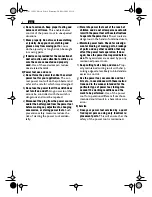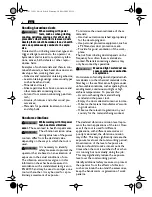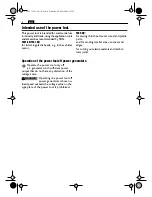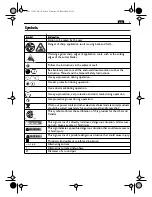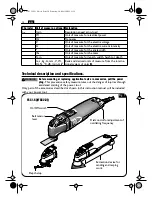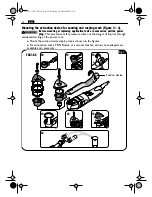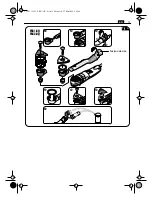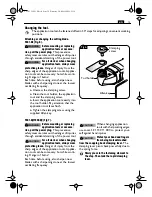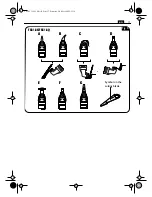
6
en
Handling hazardous dusts
When working with power
tools, such as when grinding,
sanding, polishing, sawing or for other work
procedures where material is removed, dusts
develop that are both hazardous to one’s health
and can spontaneously combust or be explo-
sive.
Contact with or inhaling some dust types can
trigger allergic reactions to the operator or
bystanders and/or lead to respiratory infec-
tions, cancer, birth defects or other repro-
ductive harm.
Examples of such materials and therein con-
tained chemicals, where hazardous dusts can
develop when working them, are:
– Asbestos and materials containing asbestos;
– Lead-containing coatings, some wood types
such as beech and oak;
– Minerals and metal;
– Silicate particles from bricks, concrete and
other materials containing stone;
– Solvent from solvent-containing paint/var-
nish;
– Arsenic, chromium and other wood pre-
servatives;
– Materials for pesticide treatment on boot
and ship hulls.
To minimise the unwanted intake of these
materials:
– Use dust extraction matched appropriately
for the developing dust.
– Use personal protective equipment, such as
a P2 filter-class dust protection mask.
– Provide for good ventilation of the work-
place.
The risk from inhaling dusts depends on the
frequency how often these materials are
worked. Materials containing asbestos may
only be worked by specialists.
Wood and light-metal dust can
cause spontaneous combustion
or explosions.
Hot mixtures of sanding dust and paint/varnish
remainders or other chemical materials in the
filter bag or the vac filter can self-ignite under
unfavourable conditions, such as sparking from
sanding metal, continuous sunlight or high
ambient temperatures. To prevent this:
– Avoid overheating the material being
sanded and the power tool.
– Empty the dust collector/container in time.
– Observe the material manufacturer’s work-
ing instructions.
– Observe the relevant regulations in your
country for the materials being worked.
Hand/arm vibrations
While working with this power
tool, hand/arm vibrations
occur.
These can lead to health impairments.
The vibration emission value
during actual use of the power
tool can differ from the declared value
depending on the ways in which the tool is
used.
It is necessary to identify
safety measures to protect the
operator that are based on an estimation of
exposure in the actual conditions of use.
The vibration emission level given in this
information sheet has been measured in
accordance with a standardised test given in
EN 60745 and may be used to compare one
tool with another. It may be used for a pre-
liminary assessment of exposure.
The declared vibration emission level repre-
sents the main applications of the tool. How-
ever if the tool is used for different
applications, with different accessories or
poorly maintained, the vibration emission
may differ. This may significantly increase the
exposure level over the total working period.
An estimation of the level of exposure to
vibration should also take into account the
times when the tool is switched off or when
it is running but not actually doing the job.
This may significantly reduce the exposure
level over the total working period.
Identify additional safety measures to protect
the operator from the effects of vibration
such as: maintain the tool and the accessories,
keep the hands warm, organisation of work
patterns.
WARNING
CAUTION
WARNING
WARNING
WARNING
3 41 01 120 21 0.book Seite 6 Dienstag, 26. Mai 2009 2:21 14




